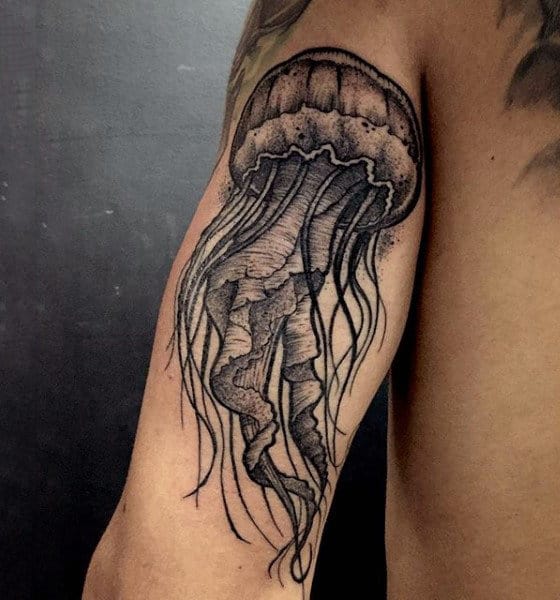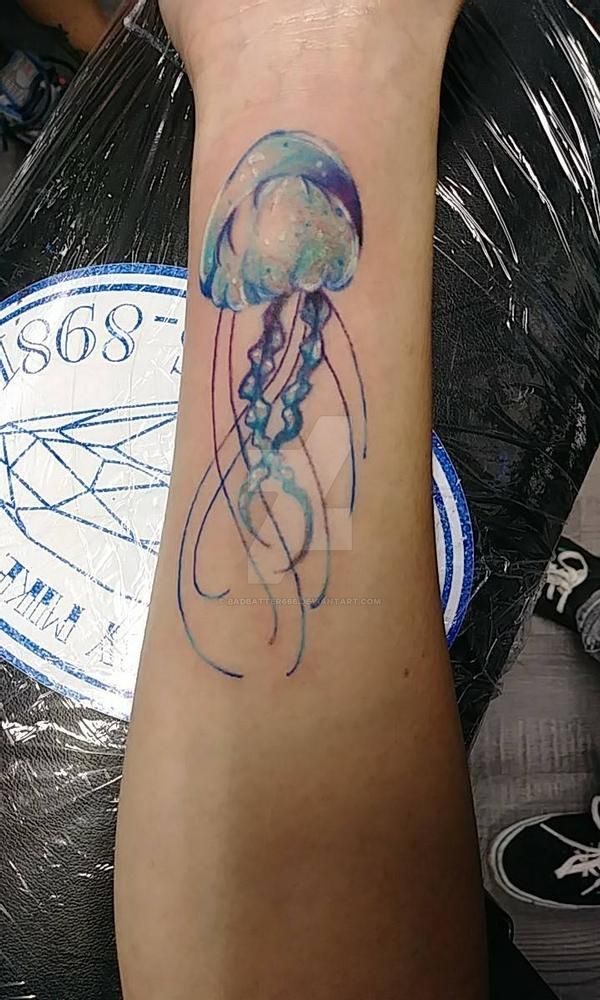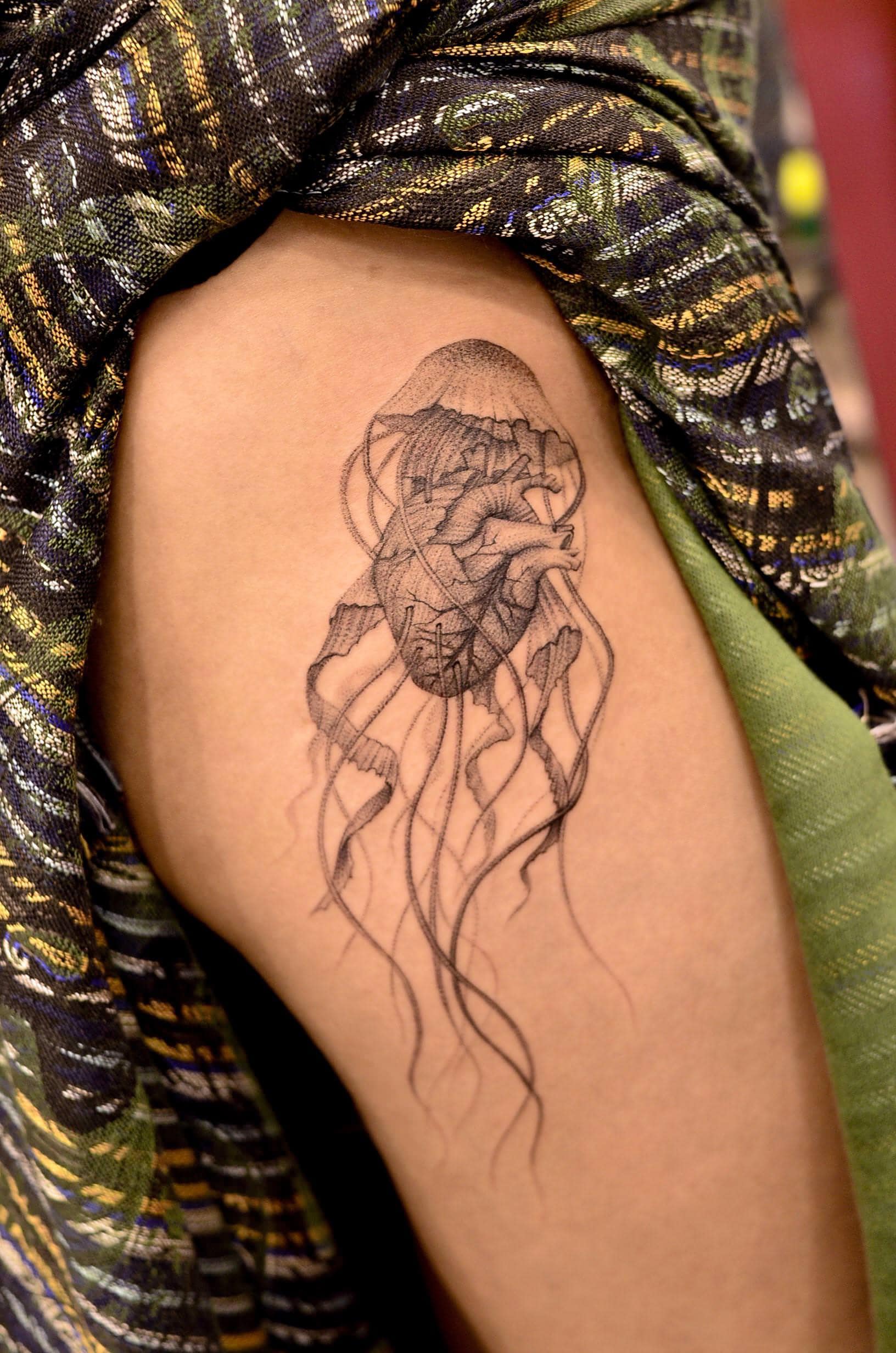Jellyfish Tattoo Variations
Generally, you will get a jellyfish tattoo that looks exactly the way you imagined it would. Nevertheless, there are many different types of jellyfish tattoos that will change the meaning as well as the look of the tattoo. Jellyfish tattoos can be done in many different ways.
A watercolor jellyfish tattoo seems appropriate in honor of jellyfish living in the ocean. Using the whimsical and magical watercolor style, the tattoo design possessed an air of mystery. The hypnotic movements of jellyfish caught my attention. An animal of this type is a strange creature, and to have it tattooed in this way makes it even stranger.
Realism Jellyfish Tattoo
Upon finding the artist, the realistic jellyfish tattoo is quite impressive. Tattoos like this one can make you feel as if you are right there with the jellyfish, and they are very captivating. To avoid getting a tattoo you don't like, make sure the artist you choose is familiar with the realism style, or else you might end up with a tattoo you don't like.
Tattoos of jellyfish are appropriate for ocean scenes. This tattoo may appear if there is a lot of space to fill. A mural of an ocean scene or jellyfish can be painted on your back or leg depending on its size. You can also get fish and coral reef tattoos.
Jellyfish tattoos are a popular choice among fans of the American traditional style. In many original tattoos of the United States, images of the ocean are prominent. These tattoos are often done in a neo-traditional style because the artist uses colors that aren't typically associated with traditional American tattooing.

About the Jellyfish
We thought it would be fun to share some interesting facts and information about jellyfish in this post. There are jellyfish in sizes ranging from as small as a pinhead to as large as a person. In some countries, they're also eaten, but you can't deny that something that has existed on Earth so long has been consumed at some point.
Jellyfish are named for their resemblance to jellyfish. Their gelatinous nature and jellylike appearance make them look like jellyfish. Jellyfish do not sting, despite popular belief. Medusas sting, while comb jelly and ctenophores don't.
Blooms are among the most fascinating aspects of jellyfish. The term "bloom" describes the sudden appearance of large groups of plants or animals, and jellyfish are known to swarm by the millions. This has been observed on some beaches around the world. Swimming and fishing can be difficult when it rains.
Blooms are caused by the tides of the ocean. As jellyfish cannot swim well, they are at the mercy of ocean currents throughout their lives. There are times when two currents meet, and all the jellyfish that have been riding the current get gathered together.

Amazing Jellyfish Tattoos with Meaning
The bells of jellyfish-like invertebrates are elongated, mobile, flexible, and shaped like umbrellas.
To escape predators, they have pulsating bells and dangling tentacles that secrete a sting mechanism called a cnidocyte.
These fish are usually colorful and can be found in deep seas and surface waters. Jellyfish are popular tattoos because of their strong, protective, and defending nature.
Their designs represent strength, simplicity, and protection. Jellyfish tattoos all have their own meanings and explanations, so there is no end to the possibilities. Listed below are various types of jellyfish tattoos with their meanings and explanations.





Jellyfish
Jellyfish and sea jellies are the informal common names given to the medusa-phase of certain gelatinous members of the subphylum Medusozoa, a major part of the phylum Cnidaria. Jellyfish are mainly free-swimming marine animals with umbrella-shaped bells and trailing tentacles, although a few are anchored to the seabed by stalks rather than being mobile. The bell can pulsate to provide propulsion for highly efficient locomotion. The tentacles are armed with stinging cells and may be used to capture prey and defend against predators.
Jellyfish have a complex life cycle; the medusa is normally the sexual phase, which produces planula larva that disperse widely and enter a sedentary polyp phase before reaching sexual maturity.
Jellyfish are found all over the world, from surface waters to the deep sea. Scyphozoans (the "true jellyfish") are exclusively marine, but some hydrozoans with a similar appearance live in freshwater. Large, often colorful, jellyfish are common in coastal zones worldwide. The medusae of most species are fast-growing, and mature within a few months then die soon after breeding, but the polyp stage, attached to the seabed, may be much more long-lived. Jellyfish have been in existence for at least 500 million years, and possibly 700 million years or more, making them the oldest multi-organ animal group.
Jellyfish are eaten by humans in certain cultures. They are considered a delicacy in some Asian countries, where species in the Rhizostomae order are pressed and salted to remove excess water. Australian researchers have described them as a "perfect food", sustainable, and protein-rich but relatively low in food energy.
They are also used in research, where the green fluorescent protein used by some species to cause bioluminescence has been adapted as a fluorescent marker for genes inserted into other cells or organisms.
The stinging cells used by jellyfish to subdue their prey can injure humans. Thousands of swimmers worldwide are stung every year, with effects ranging from mild discomfort to serious injury or even death. When conditions are favourable, jellyfish can form vast swarms, which can be responsible for damage to fishing gear by filling fishing nets, and sometimes clog the cooling systems of power and desalination plants which draw their water from the sea.